Kultur in Gefahr - ITI
Kultur in Gefahr - ITI
Kultur in Gefahr - ITI
You also want an ePaper? Increase the reach of your titles
YUMPU automatically turns print PDFs into web optimized ePapers that Google loves.
54 Artistic Expression <strong>in</strong> a Corporate World<br />
Artistic Expression <strong>in</strong> a Corporate World 55<br />
(Doyle 2002: 159). How to approach this issue? In theory, if all companies<br />
are relatively small there is no problem because no one company has a<br />
significantly bigger size or greater power than other companies. This is<br />
exactly the objective we are try<strong>in</strong>g to reach <strong>in</strong> the exercise of this part of<br />
the book: the oversized cultural conglomerates should no longer dom<strong>in</strong>ate<br />
the cultural field.<br />
Let us try to imag<strong>in</strong>e what the next step could or should be.<br />
Shouldn’t cultural companies be made smaller before they are allowed to<br />
operate <strong>in</strong> a specific national market? I agree, that this is a proposal that<br />
we, children of the neoliberal era, cannot fully comprehend. But, isn’t the<br />
logical consequence of this that the cultural play<strong>in</strong>g field must not become<br />
dom<strong>in</strong>ated by any one cultural enterprise <strong>in</strong> any way? The side effect is<br />
that we will no longer have the fierce competition that presently exists<br />
between the few rema<strong>in</strong><strong>in</strong>g cultural giants. The argument that they should<br />
have the economies of scale, and therefore the ability to merge, goes to<br />
ru<strong>in</strong>. The diversity of artistic expression needs a beneficial <strong>in</strong>efficiency.<br />
Even the very idea of own<strong>in</strong>g cultural expression is a strange<br />
concept <strong>in</strong> most cultures. This concerns the control of the means of<br />
production, distribution, promotion and reception of works of art,<br />
enterta<strong>in</strong>ment and design; this subject will be discussed <strong>in</strong> this part of the<br />
book. But, it also matters <strong>in</strong> the field of <strong>in</strong>tellectual property rights. Sure,<br />
artists must make a liv<strong>in</strong>g from their work. But isn’t it exaggerated to grant<br />
them (and most of their <strong>in</strong>termediaries: the cultural <strong>in</strong>dustries) an exclusive<br />
monopolistic right (for more than a century) on their cultural expressions<br />
which they derive for the most part from many different sources <strong>in</strong> the<br />
public doma<strong>in</strong>?<br />
Ownership regulations concern<strong>in</strong>g the different fields of the arts (<strong>in</strong> the<br />
material, audiovisual or digital worlds) may have several faces, as<br />
discussed below: (a) no private ownership entitlement at all; followed by<br />
regulations concern<strong>in</strong>g (b) horizontal, (c) vertical, (d) cross ownership, and<br />
(e) foreign ownership regulations; (f) regulations concern<strong>in</strong>g <strong>in</strong>formal<br />
market dom<strong>in</strong>ations; (g) competition law; (h) taxation as a tool for<br />
dim<strong>in</strong>ish<strong>in</strong>g the control possibilities for cultural conglomerates; and (i) the<br />
reduction of excessive copyright protection.<br />
In every situation the relevant question is on what criteria<br />
ownership restrictions should be imposed. There are several possibilities:<br />
audience time, viewer share; turnover, market share; net advertisement<br />
revenues; production, distribution, and/or performance capacity; access<br />
po<strong>in</strong>ts. Followed immediately by the question, <strong>in</strong> what quantities?<br />
(a) In a world <strong>in</strong> which it has very nearly become self-evident that<br />
everyth<strong>in</strong>g can, and must be owned privately, it may sound strange to<br />
claim that important segments of our communication tools should be not<br />
be owned by anybody and should stay <strong>in</strong> the public doma<strong>in</strong>. Lawrence<br />
Lessig stipulates, however, that the state should regulate that the<br />
spectrum stays embraced <strong>in</strong> the field of the public doma<strong>in</strong>. His argument is<br />
that ‘free resources have been crucial to <strong>in</strong>novation and creativity; that<br />
without them, creativity is crippled. Thus, and especially <strong>in</strong> the digital age,<br />
the central question becomes, not whether government or the market<br />
should control a resource, but whether a resource should be controlled at<br />
all. Just because control is possible, it doesn’t follow that it is justified.’<br />
(2002: 14). There is a need to get a broad public understand<strong>in</strong>g re this<br />
problem and there is not much time to lose. Only then can the privatisation<br />
of the spectrum be prevented.<br />
(b, c and d) It is becom<strong>in</strong>g more and more clear, that nearly all forms of<br />
horizontal and vertical <strong>in</strong>tegration no longer exist. Mostly, what we see,<br />
nowadays, are forms of cross ownership <strong>in</strong> the cultural field: media<br />
conglomerates that are active <strong>in</strong> all the fields of the arts and enterta<strong>in</strong>ment,<br />
<strong>in</strong> all stages from production to distribution, promotion, and reception, and<br />
<strong>in</strong> all different media. In several cases we should realise that the reality is<br />
that cultural production and distribution has become <strong>in</strong>volved <strong>in</strong><br />
situations of cross <strong>in</strong>dustry ownership. For <strong>in</strong>stance, General Electrics,<br />
which is a huge military <strong>in</strong>dustry, has extensive <strong>in</strong>terests <strong>in</strong> cultural<br />
<strong>in</strong>dustries and news agencies. Arms producer Lagardère <strong>in</strong> France owns a<br />
substantial part of the publish<strong>in</strong>g houses and distribution channels for<br />
newspapers and books <strong>in</strong> this country after it took over the publish<strong>in</strong>g<br />
division of Vivendi Universal.. Italian Prime M<strong>in</strong>ister Berlusconi owns<br />
many different media; controls public radio and television, is also owner of<br />
the ma<strong>in</strong> publicity agency <strong>in</strong> Italy and one the most important supermarket<br />
cha<strong>in</strong>s. Such forms of cross <strong>in</strong>dustry ownership are a nightmare re<br />
<strong>in</strong>herent conflicts, <strong>in</strong> which cultural freedom becomes extremely<br />
vulnerable.<br />
What to do? In 1996 the European Commission attempted to<br />
propose a draft Directive on media ownership which would have <strong>in</strong>cluded<br />
a 30 per cent upper limit on mono-media ownership for radio and television



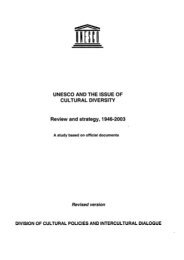

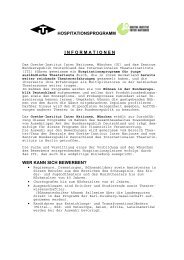

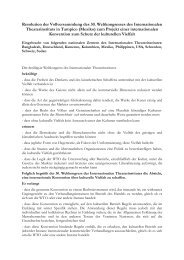
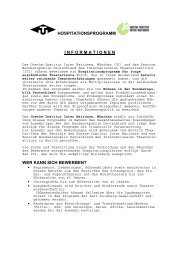
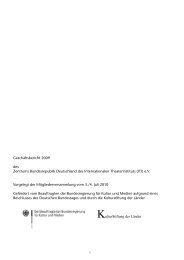
![Geschäftsbericht 2010 [pdf 2 MB] - ITI](https://img.yumpu.com/4380475/1/184x260/geschaftsbericht-2010-pdf-2-mb-iti.jpg?quality=85)